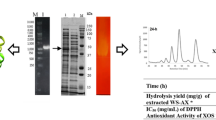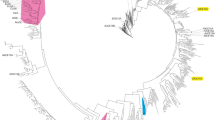Abstract
Nucleotide sequencing of a 4.15 kb DNA fragment from megaplasmid 2 of Rhizobium meliloti 2011 revealed the location of the genes exoH, exoK and exoL. The putative proteins encoded by these genes have molecular weights of 41, 30, and 44 kDa, respectively. The hydrophobicity profile of the ExoH amino acid sequence resembles that of transmembrane proteins. The predicted exoL gene product does not contain hydrophobic regions, indicating a cytoplasmic localization. The exoK gene product is characterized by a putative signal peptide and exhibits significant homology to endo-β-1,3 1,4-glucanases of bacilli and Clostridium thermocellum. R. meliloti exoK mutants induced pink nodules and synthesized a reduced amount of exopolysaccharide (EPS). Colonies of this mutant showed a delay in the appearance of the Calcofluor white fluorescence. In addition, the formation of the characteristic halo was strongly delayed. R. meliloti exoL and exoH mutants induced pseudonodules. The exoH, but not the exoL mutant, synthesized an EPS that could be precipitated by cetyl pyridinium chloride (CPC) and also by ethanol. Plasmid integration mutagenesis revealed promoter regions preceding exoH, exoK and exoL.
Similar content being viewed by others
References
Aman P, McNeil M, Franzen L, Darvill AG, Albersheim P (1981) Structural elucidation using HPLC-MS and GLC-MS of the acidic polysaccharide secreted by Rhizobium meliloti strain 1021. Carbohydr Res 95:263–282
Arnold W, Pühler A (1988) A family of high-copy-number plasmid vectors with single end-label sites for rapid nucleotide sequencing. Gene 70:171–179
Bauer WD (1981) Infection of legumes by Rhizobia. Annu Rev Plant Physiol 32:407–449
Beringer JE (1974) R-factor transfer in Rhizobium leguminosarum. J Gen Microbiol 84:188–198
Borriss R, Buettner K, Maentsaelae P (1990) Structure of the beta1,3-1,4-glucanase gene of Bacillus macerans: Homologies to other beta-glucanases. Mol Gen Genet 222:278–283
Buendia AM, Enenkel B, Köplin R, Niehaus K, Arnold W, Pühler A (1991) The Rhizobium meliloti exoZ/exoB fragment of megaplasmid 2: ExoB functions as a UDP-glucose-4-epimerase and ExoZ shows homology to NodX of Rhizobium leguminosarum biovar viciae strain TOM. Mol Microbiol 5:1519–1530
Casse F, Boucher C, Julliot JS, Michel M, Dénarié J (1979) Identification and characterization of large plasmids in Rhizobium meliloti using agarose gel electrophoresis. J Bacteriol 113:229–242
Chaplin MF, Kennedy SF (1986) Carbohydrate analysis. A practical approach. IRL Press, Oxford, Washington DC
Chou PY, Fasman GD (1978) Prediction of the secondary structure of proteins from their amino acid sequence. Adv Enzymol 47:45–148
Eisenberg D, Schwarz E, Komaromy M, Wall R (1984) Analysis of membrane and surface protein sequences with the hydrophobic moment plot. J Mol Biol 179:125–142
Engelman DM, Henderson R, McLochlen AD, Wallace BA (1980) Path of the polypeptide in bacteriorhodopsin. Proc Natl Acad Sci USA 77:2023–2027
Finan TM, Hirsch AM, Leigh JA, Johansen E, Kuldau GA, Deegan S, Walker GC, Signer ER (1985) Symbiotic mutants of Rhizobium meliloti that uncouple plant from bacterial differentiation. Cell 40:869–877
Forshauer S, Green GN, Boyd D, McGovern K, Beckwith J (1988) Genetic analysis of the membrane insertion and topology of MalF, a cytoplasmic membrane protein of E. coli. J Mol Biol 200:267–271
Hawley DK, McClure WR (1983) Compilation and analysis of Escherichia coli promoter sequences. Nucleic Acids Res 11:2237–2255
Heery DM, Gannon F, Powell R (1990) A simple method for subcloning DNA fragments from gel slices. Trends Genet 6:173
Henikoff S (1984) Unidirectional digestions with exonuclease III creates targeted breakpoints for DNA sequencing. Gene 28:351–359
Hofemeister J, Kurtz A, Borriss R, Knowles J (1986) The β-gluca-nase gene from Bacillus amyloliquefaciens shows extensive homology with that of Bacillus subtilis. Gene 49:177–187
Hohn B (1979) In vitro packaging of lambda and cosmid DNA. Methods Enzymol 68:299–309
Hynes MF, Simon R, Müller P, Niehaus K, Labes M, Pühler A (1986) The two megaplasmids of Rhizobium meliloti are involved in the effective modulation of alfalfa. Mol Gen Genet 202:356–362
Keller M, Arnold W, Kapp D, Müller P, Niehaus K, Schmidt M, Quandt J, Weng WM, Pühler A (1990) Rhizobium meliloti genes involved in exopolysaccharide production and infection of alfalfa nodules. In: Silver S, Chakrabarty AM, Iglewski B, Kaplan S (eds) Pseudomonas: biotransformations, pathogenesis, and evolving biotechnology. ASM, Washington, pp 91–97
Leigh JA, Lee CC (1988) Characterization of polysaccharides of Rhizobium meliloti exo mutants that form ineffective nodules. J Bacteriol 170:3327–3332
Leigh JA, Signer ER, Walker GC (1985) Exopolysaccharide deficient mutants of Rhizobium meliloti that form ineffective nodules. Proc Natl Acad Sci USA 82:6231–6235
Leigh JA, Reed JW, Hanks JF, Hirsch AM, Walker GC (1987) Rhizobium meliloti mutants that fail to succinylate their Calcofluor-binding exopolysaccharide are deficient in nodule invasion. Cell 51:579–587
Lipman DJ, Pearson WR (1985) Rapid and sensitive protein similarity searches. Science 277:1435–1441
Lloberas J, Perez-Pons JA, Querol E (1991) Molecular cloning, expression and nucleotide sequence of the endo-β-1,3-1,4-Rhizobium meliloti 2011 revealed the location of the genes d-glucanase gene from Bacillus licheniformis. Predictive structural analyses of the encoded polypeptide. Eur J Biochem 197:337–343
Long SR (1989) Rhizobium-legume nodulation: life together in the underground. Cell 56:203–214
Long S, Reed JW, Himawan J, Walker GC (1988) Genetic analysis of a cluster of genes required for synthesis of the Calcofluorbinding exopolysaccharide of Rhizobium meliloti. J Bacteriol 170:4239–4248
Maniatis T, Fritsch EF, Sambrook J (1982) Molecular cloning. A laboratory manual. Cold Spring Harbor Laboratory Press, Cold Spring Harbor
Meade HM, Long SR, Ruvkun GB, Brown SE, Ausubel FM (1982) Physical and genetic characterization of symbiotic and auxotrophic mutants of Rhizobium meliloti induced by transposon Tn5 mutagenesis. J Bacteriol 149:114–122
Miller JH (1972) Experiments in molecular genetics. Cold Spring Harbor Laboratory Press, Cold Spring Harbor, New York
Morrison DA (1977) Transformation in Escherichia coli: cryogenic preservation of competent cells. J Bacteriol 132:349–351
Müller P, Hynes M, Kapp D, Niehaus K, Pühler A (1988) Two classes of Rhizobium meliloti infection mutants differ in exopolysaccharide production and in coinoculation properties with modulation mutants. Mol Gen Genet 211:17–26
Murphy N, McConnell DJ, Cantwell BA (1984) The DNA sequence of the gene and genetic control sites for the excreted B. subtilis enzyme β-glucanase. Nucleic Acids Res 12:5355–5367
Pridmore RD (1987) New and versatile cloning vectors with a kanamycin resistance marker. Gene 56:309–312
Priefer U (1984) Isolation of plasmid DNA. In: Pühler A, Timmis KN (eds) Advanced molecular genetics. Springer-Verlag, Berlin, pp 14–25
Priefer U, Simon R, Pühler A (1984) Cloning with cosmids. In: Puhler A, Timmis KN (eds) Advanced molecular genetics. Springer-Verlag, Berlin, pp 190–201
Reuber TL, Long S, Walker GC (1991a) Regulation of Rhizobium meliloti exo genes in free-living cells and in planta examined by using TnphoA fusions. J Bacteriol 173:426–434
Reuber TL, Reed JW, Glazebrook J, Urzainqui A, Walker GC (1991b) Analysis of the roles of R. meliloti exopolysaccharides in nodulation. In: Hennecke H, Verma DPS (eds) Advances in molecular genetics of plant-microbe interactions vol. 1. Kluwer Publ., Dordrecht, pp 182–188
Rolfe BG, Gresshoff PM, Shine J (1980) Rapid screening for symbiotic mutants of Rhizobium and white clover. Plant Sci Lett 19:277–284
Rostas K, Kondorosi E, Horvath B, Simoncsits A, Kondorosi A (1986) Conservation of extended promoter regions of modulation genes in Rhizobium. Proc Natl Acad Sci USA 83:1747–1761
Schimming S, Schwarz WH, Staudenbauer WL (1992) Structure of the Clostridium thermocellum gene licB and the encoded beta1,3-1,4-glucanase: A catalytic region homologous to Bacillus lichenases joined to the reiterated domain of clostridial cellulases. Eur J Biochem 204:13–19
Simon R (1984) High frequency mobilization of gram-negative bacterial replicons by the in vitro constructed Tn5-Mob transposon. Mol Gen Genet 196:413–420
Simon R, Priefer U, Puhler A (1983) A broad host range mobilization system for in vivo genetic engineering: transposon mutagenesis in gram-negative bacteria. Biotechnology 1:784–791
Somasegaran P, Hoben J (1985) Methods in Legume-Rhizobium Technology, NIFTAL. USA Lib Congress 87–106109
Staden R (1986) The current status and portability of our sequence handling software. Nucleic Acids Res 14:217–232
Staden R, McLachlan AD (1982) Codon preference and its use in identifying protein coding regions in large DNA sequences. Nucleic Acids Res 10:141–156
Thöny B, Hennecke H (1989) The -24/- 12 promoter comes of age. FEMS Microbiol Rev 63:341–358
Tolmasky ME, Staneloni RJ, Leloir LF (1982) Lipid-bound saccharides in Rhizobium meliloti. J Biol Chem 257:6751–6757
Urzainqui A, Walker GC (1992) Exogeneous suppression of the symbiotic deficiencies of Rhizobium meliloti exo mutants. J Bacteriol 174:3403–3406
Vieira J, Messing J (1982) The pUC plasmids, and M13mp7-derived system for insertion mutagenesis and sequencing with synthetic universal primers. Gene 19:259–268
Vincent JM (1970) A manual for the practical study of root nodule bacteria. (BP handbook no 15 Oxford)
von Heijne G (1986) A new method for predicting sequence cleavage sites. Nucleic Acids Res 14:4683–4690
Zimmermann J, Voss H, Schwager C, Stegemann J, Erfle H, Stucky K, Kristensen T, Ansorge W (1990) A simplified method protocol for fast plasmid DNA sequencing. Nucleic Acids Res 18:1067
Author information
Authors and Affiliations
Additional information
Communicated by A. Kondorosi
Rights and permissions
About this article
Cite this article
Becker, A., Kleickmann, A., Arnold, W. et al. Analysis of the Rhizobium meliloti exoH/exoK/exoL fragment: ExoK shows homology to excreted endo-β-1,3-1,4-glucanases and ExoH resembles membrane proteins. Molec. Gen. Genet. 238, 145–154 (1993). https://doi.org/10.1007/BF00279541
Received:
Accepted:
Issue Date:
DOI: https://doi.org/10.1007/BF00279541




